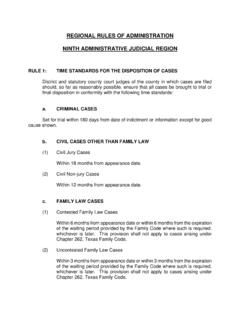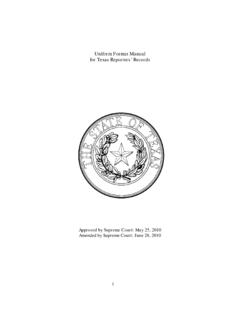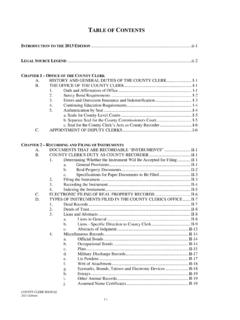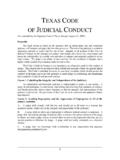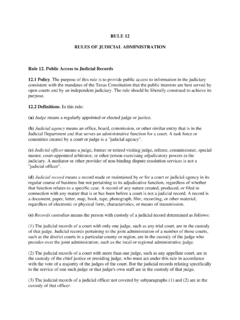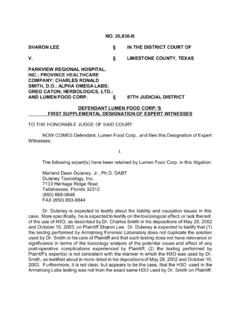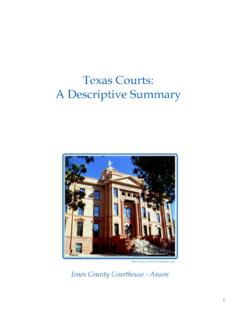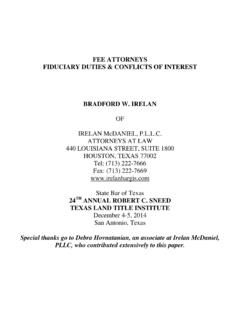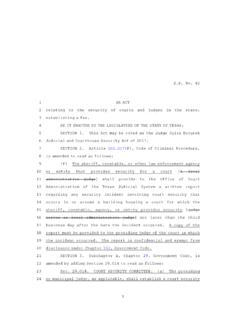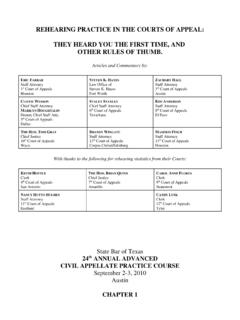Transcription of The The Texas Judicial System Texas Judicial System
1 The Texas Judicial System Prepared by the Office of Court Administration BOX 12066 AUSTIN, Texas 78711-2066 September 2014 The Texas Judicial System OFFICE OF COURT ADMINISTRATION FINANCING THE COURT System Over the past two decades, State appropriations provided for the operation of the Judicial branch of the government has averaged about one-third of one percent of the total State budget. Most of the money used to operate the courts within the Texas Judicial System is provided by the counties or cities, with a more limited amount of funds provided by the State. The State provides full funding only for the operation of the Supreme Court, the Court of Criminal Appeals, the Third Court of Appeals located in Austin, and certain statewide agencies of the Judicial branch.
2 It provides a basic appropriation for the operation of the remaining 13 Courts of Appeals. State appropriations provide the entire salaries of the justices of the Supreme Court and judges of the Court of Criminal Appeals; they also provide a base salary for the justices of the courts of appeals and the judges of the district courts, which by statute may be supplemented by local governments. The 254 counties of the State provide funds for operation of the district courts, and provide most of the funding for constitutional county courts, county courts at law, and justice of the peace courts. In most instances, the counties also provide supplemental pay to the judges of the courts of appeals and district courts serving their areas.
3 City governments provide the entire funding for the operations of their own municipal courts. 21 15-member board charged with developing and overseeing the design and implementation of a coordinated statewide computer communication network and comprehensive justice information System . The Chief Justice of the Supreme Court, the Presiding Judge of the Court of Criminal Appeals, the Chief Justices of each of the 14 Courts of Appeals, and the judges of each of the trial courts are generally responsible for the administration of their respective courts. To aid in the administration of justice in the trial courts, the State is divided into nine Administrative Judicial Regions. The Governor designates one of the active or retired district judges residing in each Administrative Judicial Region as the Presiding Judge.
4 The Presiding Judge of an Administrative Judicial Region may temporarily assign an active or retired judge to serve on a district court or county court at law in the Administrative Judicial Region whenever the need arises. The Chief Justice of the Supreme Court convenes periodic conferences of the nine Presiding Judges to ensure the efficient administration of justice in the trial courts of the State. 20 1 The Texas Judicial System Judicial Authority The Judicial power of the State of Texas is derived from Article 5, Section 1 of the Texas Constitution, which provides: The Judicial power of this State shall be vested in one Supreme Court, in one Court of Criminal Appeals, in Courts of Appeals, in District Courts, in county Courts, in Commissioners Courts, in Courts of Justices of the Peace, and in such other courts as may be provided by law.
5 The Legislature may establish such other courts as it may deem necessary and prescribe the jurisdiction and organization thereof, and may conform the jurisdiction of the district and other inferior courts thereto. (As amended November 4, 1980, effective September 1, 1981.) 2 INTRODUCTION TO THE Texas Judicial System THE Texas CONSTITUTION The basic law of the State of Texas is set out in the Constitution of the State of Texas , a document adopted by the voters of the State in 1876 and amended by them many times since then. The fundamental legal rights which all residents of the State possess such as the right to trial by a jury are set out in the Constitution in what is called the Bill of Rights. The Constitution also contains basic principles for the operation of the state government and legal System .
6 It separates the powers of the government by dividing it into three distinct branches or departments: legislative, executive, and Judicial . THE LEGISLATIVE AND EXECUTIVE BRANCHES The legislative branch includes the Texas House of Representatives and the Texas Senate, which together make up the Legislature. The function of the Legislature is to make laws, which are called statutes. Statutes, written and passed by the Legislature, include such things as the law which makes it illegal to drive while intoxicated and the law which makes the Fourth of July a state holiday. The Constitution, adopted by the voters themselves, is superior to the statutes passed by the elected members of the Legislature. For this reason, if there is a conflict between a provision of the Constitution and that of a statute, the statute is said to be "unconstitutional" and may not be enforced.
7 The role of the executive branch is to carry out and enforce the laws of the State. The executive branch includes the Office of the Governor and most administrative agencies of the State, such as the Department of Public Safety, the Texas Education Agency, and the Department of State Code establishes professional standards which the State Constitution makes mandatory for judges. In addition, the Constitution establishes a special commission to consider citizen complaints concerning the conduct of judges which is clearly inconsistent with the proper performance of their duties, or which casts public discredit upon the judiciary or the administration of justice. This Commission on Judicial Conduct may reprimand or censure a judge, or recommend to a review tribunal that the judge be removed from office.
8 The Commission may also suspend from office judges who are indicted for felony offenses or charged with official misconduct. It does not, however, review the legal results of a trial as this is within the jurisdiction of the appellate courts. Judicial ADMINISTRATION The Supreme Court of Texas has general responsibility for the efficient administration of the Texas Judicial System and the authority to make rules of administration applicable to the courts. Aiding the Supreme Court in carrying out its administrative duties is the state Office of Court Administration, which operates under the direction of the Chief Justice. The Supreme Court and the Legislature receive recommendations on long-range planning and improvements in the administration of justice from the Texas Judicial Council, a 22-member advisory board composed of appointees of the Judicial , executive, and legislative branches of government.
9 The state Office of Court Administration, established in 1977, provides administrative support and technical assistance to all of the courts in the State. It publishes the Annual Report on the Texas Judicial System and provides the Legislature with requested information on the functioning of the Judicial System . The office also supports the research and operations of the Judicial Committee on Information Technology, a 19 to be licensed to practice law; most are required to be county residents and have experience as practicing attorneys. Judges of the constitutional county courts must be well informed in the law of the State but are not required to be lawyers. Most of the 254 county judges are not licensed to practice law. There are no constitutional or statutory qualifications to serve as a justice of the peace, and very few are lawyers.
10 While judges of municipal courts of record must be attorneys, no statutory qualifications are required of other municipal judges, most of whom are not lawyers. SELECTION AND TERMS All judges, with the exception of most municipal judges, are elected in partisan elections by the qualified voters of the geographical areas they serve. Most municipal judges are appointed by the governing body of the municipality, although a few are elected in non-partisan elections. Appellate judges serve six-year terms. District judges, county -level judges, and justices of the peace serve four-year terms. Municipal judges usually serve two-year terms. Judicial vacancies in appellate and district courts are filled by appointment of the Governor.
